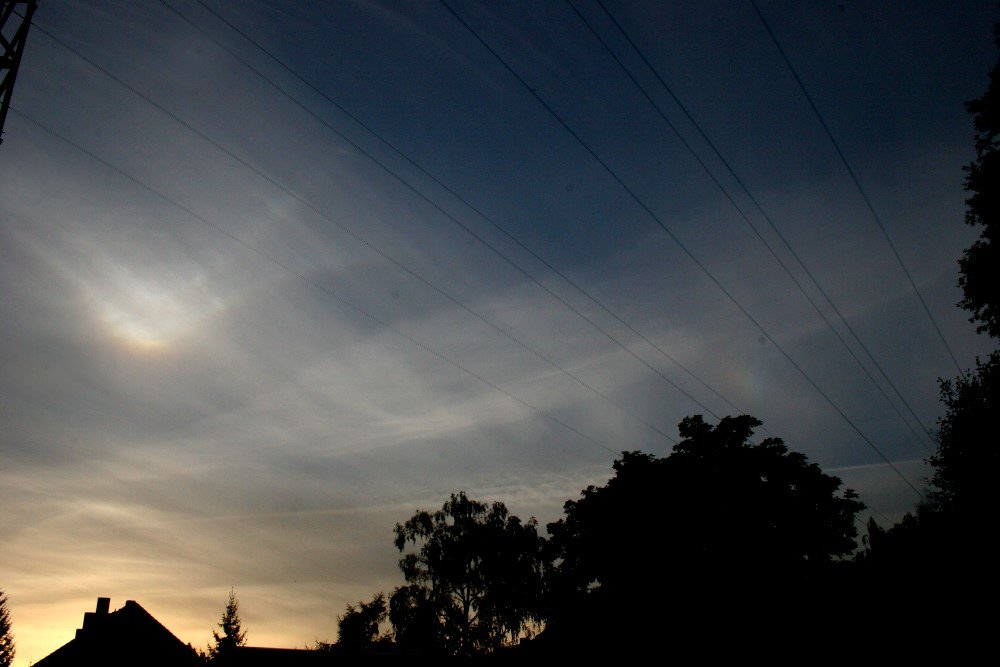
Friday, 29 September 2006
Wegener arcs in Czechoslovakia again

Sunday, 24 September 2006
From archives: odd radius column arcs in 2001

By Marko Riikonen
Monday, 18 September 2006
Lowitz arcs in Czech
 Martin Popek observed this display with Lowitz acrs on 16. September. Interesting feature is the lower Lowitz component extension above parhelion. In the simulation there is something like that, but it's very, very ghostly. The main body of the lower component below parhelion looks as if it were just a patch of 22° halo - the extension towards parhelion is missing. Same goes with the upper component. This is quite typical way of Lowitz arcs showing up. Circular component is seen only above parhelion.
Martin Popek observed this display with Lowitz acrs on 16. September. Interesting feature is the lower Lowitz component extension above parhelion. In the simulation there is something like that, but it's very, very ghostly. The main body of the lower component below parhelion looks as if it were just a patch of 22° halo - the extension towards parhelion is missing. Same goes with the upper component. This is quite typical way of Lowitz arcs showing up. Circular component is seen only above parhelion.
I was given sun elevation of 39° for this display but somewhat lower elevation gave a bit better simulation results. This is for 33°. The projection in the simulation is clearly not the same as in camera and this may have caused some of the broblems. Simulation is made with Halosim by Les Cowley and Michael Schroeder.
Be the sun elevation 39° or 33°, it does not change much anything fundamentally. Several question could be raised about this display with lenghty discussions. It seems we still have a long way to understanding Lowitz arcs.
By Marko Riikonen
V-shaped Parry and Tape's arc in Germany
 On August 31, 2006, clouds moved in destroying all hopes for meteor observations in the night. The halo display in the high clouds close to sunset (1725 UT, Sun elevation approximately 3 deg) observed by Jürgen Rendtel from Marquardt (west of Berlin, 13.0 deg E, 52.5 deg N) included intense V-shaped upper tangent and Parry arcs. Another bright coloured 'spot' of about 3 deg apparent size was found to be part of the supralateral arc and Tape's halo. The image processing by Claudia Hinz using unsharp masking also revealed the convex Parry arc.
On August 31, 2006, clouds moved in destroying all hopes for meteor observations in the night. The halo display in the high clouds close to sunset (1725 UT, Sun elevation approximately 3 deg) observed by Jürgen Rendtel from Marquardt (west of Berlin, 13.0 deg E, 52.5 deg N) included intense V-shaped upper tangent and Parry arcs. Another bright coloured 'spot' of about 3 deg apparent size was found to be part of the supralateral arc and Tape's halo. The image processing by Claudia Hinz using unsharp masking also revealed the convex Parry arc.By Claudia Hinz
Saturday, 16 September 2006
Circumscribed halo and pyramid halos in Sardinia
Thursday, 14 September 2006
A fine circumhorizontal arc from Italy

Circumhorizontal arc more than 100° wide above the horizon, very brilliant, for about 25 minutes. The best I have seen from Italy!
By Paolo Candy
Saturday, 9 September 2006
Odd radii in Czech Republic
By Marko Riikonen

